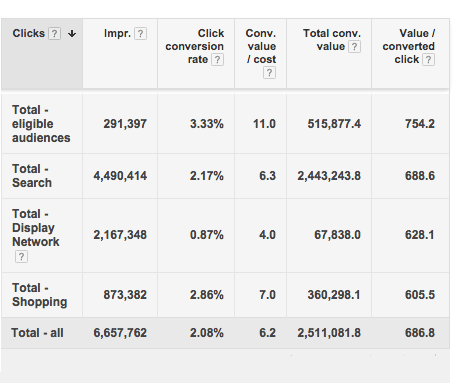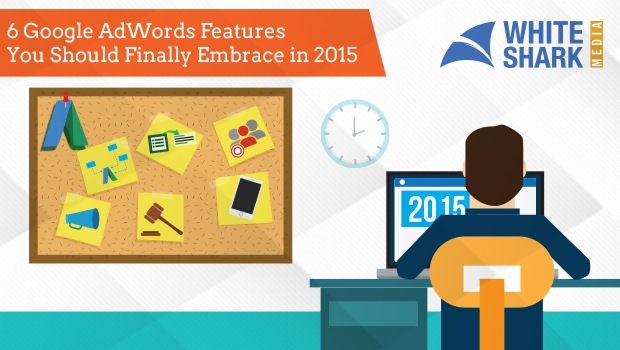We saw a lot of valuable Google AdWords features being released in 2014. This January isn’t short of blog posts mentioning the many top features that were released in 2014. But even before 2014, there were many features that aren’t being used in many advertising accounts.
This post is intended turn you from a bystander to an expert user of these features in your account. I have carefully listed who each feature is best suited for and how long it will take you to learn and implement each feature.
Callout Extensions
Level: All levels
Time to learn: 15 minutes
Time to implement: 10-60 minutes
Time to maintain: 15-30 minutes per month
We’re starting at the lighter end of new features. Callout extensions are a new ad extension that allows you to add an extra line of ad text to your ads:

On the surface, they seem similar to sitelinks, but the difference is you don’t need a unique landing page for every callout. This frees up a lot of the restrictions you’d have with sitelinks.
Using callouts is yet another way to increase the amount of ad space you take up in the search results. A great use-case for callouts is adding your more generic selling points to the callout and rewriting your ads to be more specific. We all know Free Shipping, Great Selection, Limited Time, etc. works wonderfully to increase conversions, but once we include these generic selling points there isn’t enough space left. Callout extensions allow you to be more creative with your ad writing. I love the new ads I’m able to write with callouts.
Just like with sitelinks, you can add callouts on the account level, so you can get started in just 10 minutes by adding five callouts you believe apply to all your ads, such as:
- Free Shipping
- Free Returns
- Day-to-day shipping
- Authorized Reseller
- 24/7 Customer Service
- Online Chat
- Personal Support
- Price match
- Covers the metro area
- Servicing Entire Florida
You can see a video of what callout extensions are, and how to best implement them here as well:
[youtube https://www.youtube.com/watch?v=PGgCxjVsZfo&w=640&h=360]
Bid Strategies
Level: Advanced
Time to learn: 1 hour
Time to implement: 10-60 minutes
Time to maintain: 3-4 hours per month
Granted, bid strategies are one of the Google AdWords features that I’ve been very reluctant to implement. There are so many thoughts about how to do proper bid management, and I’ve tried many different tools to try to make it more effective.
I’ve tried everything from Excel sheets to PPC management software like Marin and Doubleclick, and lastly AdWords Scripts.
AdWord Scripts gave me the best results while saving me time, as opposed to Excel sheets. However, it was still an awfully manual process and releasing scripts on many accounts with individual targets proved to be less than effective.
Upon the advice of a good friend, I decided to take a look at Bid Strategies inside Google AdWords. My tests took part in the last two quarters of the year, and I saw good results overall. I’m planning on writing a follow-up post with the results from the implementation, but the results have been good so far.
One of the things I saw during the Christmas season was fewer keywords with super high ROI and low amount of conversions. If combined with an average position lower than 3.0, it’s usually a sign of missed opportunity. Comparing campaigns with bid strategies turned on vs. manual bidding, I saw a bit lower pure ROI, but more sales, and thereby more money in the pocket of my clients.
I used the Target Return on Ad Spend feature.
When implementing bid strategies, be careful with assuming it will fix your account’s poor performance. Yes, the proper bid management will help you get the most out of your account, but if you are currently seeing low to no conversions, then you need to optimize your account as whole – not just the bidding.
Remarketing/Audiences for Search
Level: Medium
Time to learn: 3 hours
Time to implement: 45-60 minutes
Time to maintain: 2 hours per month
Can you guess what type of campaign was my top-performer throughout entire 2014? It was my remarketing for search (RLSA) campaigns/audiences.
My remarketing audiences brought in one case 20% of the revenue in at half the cost:

Note that this is the combined stats for the entire year. The performance was stellar throughout the year, and I’m eager to take even more advantage of it in the future.
As I have said many times before, I sincerely believe as Google expands their AdWords platform, they will implement features such as audiences and other non-keyword ways of targeting users.
Start now and embrace the remarketing audiences for search opportunity you have. You will have to learn how to work with audiences throughout 2015, and there is no denying the results you can get from using audiences efficiently.
Want five use-cases for how to use remarketing for search? Check this SEJ article:
5 Ways to Use Remarketing for Search to Profit from Underutilized Areas in AdWords
Implement a Proper Mobile Strategy
Level: Medium
Time to learn: 45 minutes
Time to implement: 2 hours
Time to maintain: 2-4 hours per month
We have all read the numbers detailing how strong mobile search is and how the time of mobile is upon us. If you haven’t already taken advantage of the huge amount of mobile searches (and actions), it’s time to do it now.
Whether you’re a local business or e-commerce business, there are ways to benefit from having the right mobile strategy. The first steps to ensuring you are getting the most out of your mobile traffic is:
- Have a responsive or mobile-friendly website
- Write mobile-preferred ads (these ads will only show up on mobile)
- Implement bid adjustments for mobile users that match their ROI
If you don’t already have a responsive website (and I’m surprised by the number who don’t), then it’s time to move on this aspect. You’re putting money on the table every time you don’t have a mobile website. For example, I just bought an iPhone 6 Plus and even on its big screen I have a tough time navigating many websites.
Start With the Basics and Work Your Way Up
Once you have the basics in place, it’s time to think about what goals your mobile users have verses users visiting from desktops. If they’re on the go, they’re much more likely to want to take action fast. Filling out huge forms isn’t attractive, so consider leaving your many form fields behind and focus on the basics.
There are many ways to improve your mobile website further, and it can seem like a daunting task. Just start with getting a functional mobile website that caters to mobile users. By doing that you will already be miles ahead of your competition.
Third Party Tools
Level: Medium
Time to learn: 3 hours each
Time to implement: 2 hours
Time to maintain: 3-4 hours per month
There are many third-party tools popping up designed to help you optimize your Google AdWords campaigns. In the past, when you wanted to work with a PPC tool, it meant leaving everything in the AdWords interface behind and using a brand new interface. Many tools come with a steep price stamp and comprehensive onboarding, which naturally stops people in their tracks.
There haven’t been good alternatives for the mid-sized advertiser. It’s either been all-in or manual. Neither is ideal.
I’m therefore happy to have tested several tools in 2014 and can report back on several of them:
- Optmyzr from Frederick Vallaeys
- Hero Pro from Hanapin Marketing
- Adalysis from Brad Geddes
- DataFeedWatch
- WordStream
- Invoca
- Ifbyphone
I have especially found great value in Adalysis. I must admit on the surface I wasn’t too thrilled about the interface (it reminds me of something from the early 2000s). But the workflow inside and the way it has streamlined my ad tests is unbelievable.I have an Evernote doc of the top features I wanted to add in our in-house ad testing tool, and Adalysis covers most of them. It’s an absolute godsend. I will cover a complete round-up of the tool next week, so stay tuned.
Until then, just know there are several providers you should take a look at to improve your success greatly
Note: I have no affiliation with Adalysis or any other tools mentioned on this page, other than being a happy customer.
Ad Customizers
Level: Medium
Time to learn: 5 hours
Time to implement: 3-10 hours
Time to maintain: 3 hours per month
As Matt Umbro wrote towards the end of 2014, we are all very excited about the addition of Ad customizers. Ad customizers allow you to feed your ads dynamically from an Excel sheet or other files.
Some of the most common use cases are:
- Pricing
- Countdown for a sale or event
- One ad for hundreds of product keywords
Ad customizers will take you a bit longer to master, but once you do, it will save you a lot of time and provide you with better performance. The first trials we saw inside White Shark Media showed certain ecommerce stores could use ad customizers to increase sales by 25-50% overnight by simply having more specific ads.
It’s always been a challenge to constantly update and optimize hundreds or even thousands of ad groups. In the past, the best you could do was use Dynamic Keyword Insertion.
To completely understand ad customizers, this video does the trick pretty well:
[youtube https://www.youtube.com/watch?v=f2KDdxDvTTE&w=640&h=360]
For other resources, I suggest reading the following articles on ad customizers:
How To Move Forward From Here
My best recommendation for getting started is to choose just one thing to do per month. Starting something new can be hard. If you’re only managing Google AdWords as a small part of your job (i.e. not an account manager), it’s difficult to take the time to get deep into new features.
There is a reason many advertisers never use more than 10% of the features available on the Google AdWords platform. I believe the sheer amount of options available is driving advertisers to just sticking with the basics.
If you choose to do just one of these things per month, you will be able to improve your Google AdWords campaigns continuously throughout the year. Hopefully, this will also put you in the mindset to always be looking for new features to implement on a monthly basis. Whether it’s something as simple as increasing your amount of callouts to be specific to each ad group, or implementing a big new feature like ad customizers, stay on the lookout for ways to improve your ads.If you’re still lost on where to start, start with adding callouts to your campaign and then mobile ads. It’s the simplest way to get started and will provide a decent impact on your performance.
Image Credits
Featured Image: Created by White Shark Media for Search Engine Journal
All screenshots taken January 15, 2015





